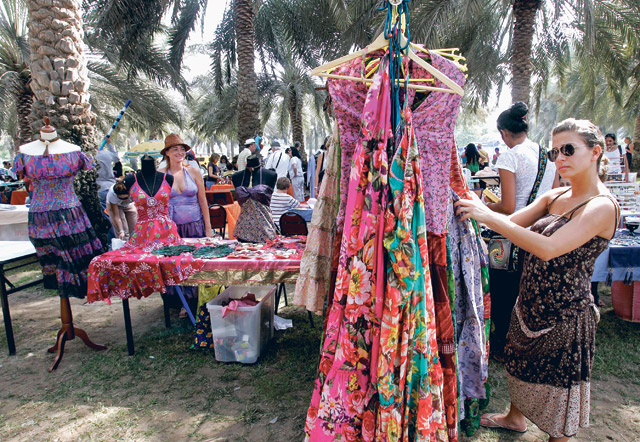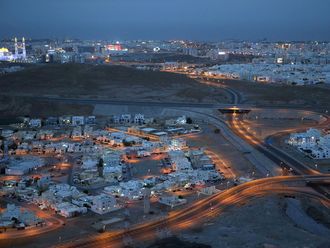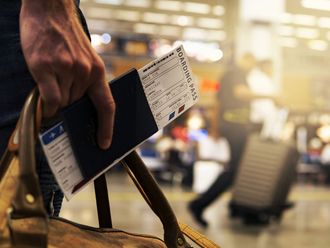
Dubai: A completely new concept in this country only a few years back, the flea market concept has quietly been gaining ground.
Now, as the concept gains popularity, most flea market founders are taking advantage of the success and expanding it into the wider business environment.
Melanie Beese, founder of the Safa Park flea market, was able to turn her hobby into a business after being made redundant.
"When you start something new you don't know if it will work. It started off as my hobby. Then I lost my job in January 2009 and couldn't get employed anywhere else. I got my own trade licence, organised other events and earned money that way," she said.
Roslynne Bourguignon, one of the founders of the Jumeirah Beach Walk Covent Garden Market, also used its success as a launch pad to exploit other market opportunities.
"Now this market is a business under an umbrella company. Although the Covent Garden Market still makes up 50 per cent of our business, we also run markets for different events and opening," she said.
"For example, we ran the night market at Atlantis and markets at the opening of Souk Al Bahar. It's quite a big operation now, not the one band company my husband and I started a while back."
The flea market concept, largely centred around the sale of second-hand products, was not very popular in this country until recently.
The global economic downturn changed that and demand for used goods is currently on the rise and promising good returns.
Although the Safa Park flea market picked up the pace recently, the history of flea markets in the UAE dates back to the 1960s. In those days, most downtown bazaars had outlets catering to used products, antiques and handicrafts.
In the 1990s, Dubai Municipality launched its famous Friday Market in Hamriya to gear up the sector.
One could also buy goods from a permanent ‘Friday Market' while driving towards Fujairah and Khor Fakkan, near the Masafi mountains. It has now become a popular tourist spot for bargain hunters.
Rapid growth
Starting off with 70 stalls and 1,500 visitors, Beese said the market had grown rapidly since its inception in 2009.
Now, the market averages 150-250 stands with Safa Park attracting about 5,000-6000 bargain hunters.
Although its popularity has led to developers seeking to open new markets in their developments, Beese is very conscious about not over-flooding the market.
"I don't think these events should be held too often; people will get sick and tired of [the concept]. It needs to stay a novelty for it to work."
Beese, however, said she does have plans to take the concept to the other GCC countries such as Kuwait, Oman and Qatar.
Paul Townsend, co-founder of Arte market, is not worried about the increase in markets.
"They are all very different markets and it's better to keep them separate. People go to the flea market specifically to get bargains, while others might go to an art fair with a bit more money to get more unique products and the Covent Garden is very much a tourist footfall."
The presence of a market also has several advantages for surrounding areas. The upcoming DIFC market aims to attract a higher footfall on weekends.
Townsend says the business a market attracts to a mall is substantial.
"From our Christmas event which was held in Times Square, the typical numbers for the mall would have been 5,000. They went up to 20,000 because we were there," Townsend said.
As a market that promotes arts and crafts, Townsend says the venue is also a chance for people to collaborate and bounce new product ideas off each other.
"Now that we have a lot of new people setting up stalls, we'll have a chat with them, get to know them; hopefully that's how the community keeps growing. We've seen a lot of members bounce ideas off each other and collaborate," he said.
The increased popularity of markets has partly been a by-product of the downturn.
Townsend says that while he's seen a steady increase in the number of stalls, he's also seen a shift in their purpose.
"Around this time last year we had about 45-50 stalls; now we're up to nearly 100. We are also seeing a lot more stall-holders who don't have regular jobs and are a lot more focused on selling. Before, it would have been a bit of pocket money; now people are focusing on making money rather than just showcasing their hobby," he said.
Miriam Walsh, co-founder and stall-holder at the Arte market, said that she turned to flea markets to make more income after she fell on hard times.
"Before Christmas, my husband was made redundant. I found that there were 19 markets in schools, clubs... over an eight-week period I could sign up to sell my products," she said.
"It didn't earn me enough money to sustain myself fully, but it gave me enough to pay for all the extras like Christmas and to fly my daughter to Dubai."
In recent months, Bourgignon said she had also noticed a considerable shift in spending habits.
"Vendors are having to adapt to people's spending needs. People are not spending money on huge pieces of artwork anymore. There are more people going for small jewellery. In the heydays, stall-holders were able to sell paintings for Dh2,000-Dh3,000, but not any more," she said.
Townsend says there had also been a shift in the types of products sold.
"Last year, there was a lot of artwork sold as people were buying new apartments and looking to decorate them. Now people are mainly buying smaller accessories for the house and gifts," he said.
New opportunities
As well as being a fun day out on the weekends, the interactive nature of markets also presents a great opportunity for budding businesses looking to test public opinion regarding their product while building up their client base.
"A large percentage of my clientele is generated through the markets. The information I receive through the stall has proved invaluable and has greatly assisted me in some of my decision-making," said Emma Vorwerk, owner of Berry Behaved, boutique pet products which she sells at a stall at the Covent Garden market
"I always find it interesting discovering what the needs and wants are of my consumer. Some products that I have thought will not sell so well have completely proved me wrong and have exceeded all my expectations."
Holding a stall at a market also presents a more economical way for businesses to sell their product.
"It's a cheap platform for people to start up in a shop. If you rent a kiosk in a mall, we're talking a minimum of Dh200,000, which you have to pay three months in advance, and on top of that you have to have a trade licence.
"At the end of it you're looking at not much change out of [the investment] and still have to pay for staff," Townsend said.
On average, a stall is sold for about Dh200-Dh300.
Bourgignon said much effort is needed if a stall is going to be successful. It includes initiatives such as introducing a guest book to record the phone numbers of potential customers, promoting interaction with customers and doing your own marketing.
Pricing is also another important aspect.
"We guide people a little bit with pricing. You need to make sure not to undersell yourself but also not make it too pricey. We had someone trying to sell mosaic work for about Dh2,000, which they're never going to sell," Townsend said.
"We suggested they do it for something a little less and if it's too expensive to produce, [then] they should just find a cheaper way to produce it."
The benefits also trickle back to the overall market, Townsend said.
"If the market has nice-looking stalls with friendly, interactive stall-holders then people will want to come back," he said.
Location
An aspect that makes or breaks a market is its location.
"You need to hold it in a residential area with nice restaurants and a constant flow of tourists," Bourgignon said.
"You need people to come every week and a decent entity of residents around the area. Open parks don't to do so well because generally, people will browse but not buy."
Markets can also benefit from the weekend footfall at malls.
Seasons and public holidays also determine the peaks and troughs of market footfall. Those in the industry say the busiest times are just before Eid, the periods leading up to Christmas and during the summer months.
"We try to encourage stall owners to cater to events like Valentine's Day, Mother's Day and Easter. Everyone in the market needs to get smarter at those types of things in order to sell for occasions," Walsh said.
Do you shop at flea markets? Do you think the concept is interesting? Are such markets a good way to offload products that you do not use anymore?













